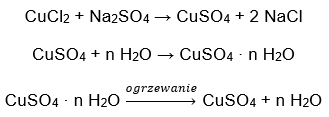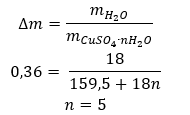In chemistry, some chemical compounds form special bonds with water molecules. These are not chemical bonds, but short-range interactions that specifically determine the properties of these compounds. We are talking about hydrates. Their properties are readily used in selected industrial sectors. The most popular hydrated salt is undoubtedly gypsum, or calcium sulphate dihydrate (VI), which is an important raw material in the construction industry. Hydrates are also very good indicators of moisture content. This is related to the fact that the colour of the anhydrous salt is often different from that of the hydrated salt.

Hydrates
Hydrates are not chemical compounds in which chemical bonds, such as covalent bonds, occur between the water molecules and the molecules of the given salt. They are also not coordination compounds. The formation of hydrogen bonds, which are much weaker in strength than chemical bonds, is characteristic of these structures. Hydrates are structured in the form of a crystal lattice. The water molecules are irregularly distributed in it. The term “water of crystallisation” is often used.
Hydrates are obtained by hydration. Salt molecules, especially inorganic acid derivatives, are most likely to undergo this reaction. Hydration involves the transformation of anhydrous crystals into hydrated ones. It can cause a change in the mineral mass, but does not destroy it. Hydration often accompanies other processes, such as carbonation. Hydration chemicals, under normal conditions, are characterised by high hygroscopicity, i.e. a strong affinity for water molecules. Such substances are capable, for example, of absorbing moisture from the air. Another way to obtain hydrates is to crystallise them from aqueous solutions.
The molecular formulae of hydrates are formed by writing down the salt formula and stating the number of hydrated water molecules. In order to provide a general notation, the letter ‘n’ is placed before ‘H2O’. Its values are greater than one and it corresponds to the number of water molecules attached. The most common distinctions are between hydrates with n=½ (hemihydrate), n= 1 (monohydrate), n=2 (dihydrate) and n=3 (trihydrate). Importantly, the same substance can attach different numbers of water molecules.
![]()

Given that there are hydrogen bonds between the salt molecules and the water molecules, these compounds do not show satisfactory resistance to elevated temperatures. When they are heated, they disintegrate and change to anhydrous forms. Hydrates dissolve very well in water. In aqueous solutions, hydrated water molecules attached to the salt are released. This fact should be taken into account, for example, when making solutions of these substances. Failure to take into account the degree of hydration of a given compound results in errors, if only in the determination of the concentration of the solution. An important characteristic of hydrated salts is the change in their colour due to the attachment of water molecules in the hydration reaction. It should be noted that the hydrated forms show significantly less hygroscopicity compared to the anhydrous salts.
Hydrates of inorganic compounds
Salts of inorganic acids are substances that are by far the most likely to form hydrates with water molecules. The most common hydrates of inorganic compounds include:
- Copper (II) sulphate hydrate (VI), CuSO4 – copper (II) sulphate (VI) adopts various degrees of hydration. The maximum number of water molecules attached is five. As a result of heating the pentahydrate of this salt, water molecules are stripped off. First two and a trihydrate are formed, and on further heating of the system, copper (II) sulphate monohydrate (VI) can be obtained. To remove the last water molecule, it is necessary to heat the compound to a temperature of more than 200 ᵒC. Copper (II) sulphate hydrates (VI) are blue in colour, which is caused by the presence of water of crystallisation around the copper ions. Whereas anhydrous salt is white in colour. Its high hygroscopicity and ability to form hydrates is used to remove moisture from some liquids.


- Cobalt (II) chloride hydrate, CoCl2 – anhydrous cobalt (II) chloride is highly hygroscopic. Thanks to its strong affinity for water molecules, it is capable of absorbing moisture even from the air. This process results in the formation of hydrates of this salt. The most common hydrated form is cobalt (II) chloride hexahydrate – CoCl2 * 6H2 Another form is the dihydrate molecule. This salt also shows the ability to change colour depending on its moisture content. Anhydrous salt is blue, dihydrate takes on a pinkish-purple colour, and the colour of the hexahydrate molecule is intense red.
- Sodium sulphate hydrate (VI), Na2SO4 – this salt exists in the form of two hydrates: heptahydrate (five water molecules in the structure) and decahydrate (ten water molecules in the structure). The anhydrous form of sodium sulphate (VI) occurs in nature as the rare mineral thénardite. Sodium sulphate ten-hydrate (VI) is the so-called Glauber’s salt. It is widely used in the production of glass, paper, laundry detergent and soda. Glauber’s salt is also one of the ingredients necessary for the production of the blue pigment ultramarine. In addition, the compound has a therapeutic effect on the digestive system, due to its laxative properties.

Gypsum
An example of an inorganic salt hydrate of global importance and wide application is gypsum. It is a mineral made up of the hydrated form of calcium sulphate (VI), CaSO4. Crystalline gypsum is the dihydrate of this salt. Under natural conditions, it is formed during the evaporation of salt water from lakes and rivers, at temperatures below 42ᵒC. Anhydrous calcium sulphate (VI) is anhydrite. It is also referred to as anhydrous gypsum. Building gypsum, on the other hand, is calcium sulphate hemihydrate (VI). Which form of this salt is obtained depends on the temperature prevailing during the processing of the parent sedimentary rock. Gypsum used in construction is usually a mixture of different forms of hydrated lime salt.


The application possibilities for gypsum are very wide, especially in the construction industry. The most important uses of this salt hydrate are listed below:
- In the construction industry, gypsum is used in finishing elements. It is one of the components of loose semi-finished products, mortars, adhesives, gypsum-based finish and ready-mixed assembly components, e.g. plasterboard.
- Medicine uses plaster to brace broken limbs. Gypsum bandages are considered to be skin-friendly. In addition, the material is also used in dental technology laboratories.
- The industry uses gypsum in modelling and design workshops. Plaster casts are very suitable for shaping various utilitarian objects.
- Gypsum is an additive to some fertilisers used in agriculture.

Methane clathrates
Methane clathrates belong to a group of compounds known as gas hydrates. They are responsible for most of the rapid climate change in Earth’s history. Methane clathrates are also often referred to as methane hydrates or methane ice. They form a solid form of water and methane. Their molecules are distinguished by their crystalline structure. They are formed under increased pressure. They take the form of white, odourless solids, which are often similar, in terms of external appearance, to ice. Interestingly, they resemble polystyrene to the touch. Clathrates are unique chemical groupings. Water molecules form a structure that resembles a cage. Methane is stored inside this cage. Importantly, the two substances do not form chemical bonds with each other. Typically, methane clathrates consist of 46 water molecules surrounding two small and six medium-sized cages. Methane molecules are trapped inside them. Clathrates are also known to be made up of 136 water molecules with 16 small and eight large cages of methane gas inside.
In recent years, significant quantities of this resource have been discovered at the bottom of the oceans. It is attracting a lot of interest because of the potential to extract significant quantities of methane, which can be used, for instance, for energy purposes. Methane clathrates burn with an even flame, reddish in colour. After burning, molten water remains. Methane extracted in this way may be a good alternative to conventional hydrocarbon sources, but it is also quite a threat to the climate. There is still insufficient knowledge about the exploitation of methane from clathrates accumulated on the ocean floor. Uncontrolled release of significant quantities of this gas can be very dangerous, as it enhances the greenhouse effect much more strongly than carbon dioxide.